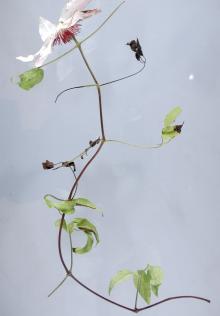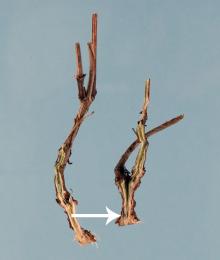Cause Calophoma clematidina (formerly Ascochyta clematidina), a fungus that overwinters in leaf and stem debris. Spores shed from pycnidia that form on old infected stems. After germination, the fungus enters leaves and stems by direct penetration of the cuticle, often, but not always, following the formation of infection structures. Although germ tubes regularly entered the plant via trichomes, stomata were not found to be sites of entry. Leaf infections can continue down the petiole and into the stem. The disease is favored by wet weather. Many of the large flowering hybrids are susceptible while the small flowered species are resistant. Sometimes called clematis wilt but it is not a vascular wilt disease.
Symptoms Leaves in the greenhouse may show small, water-soaked spots that turn buff-color with reddish margins. Leaf spots on some cultivars may have a brown center surrounded by a darker brown to black margin. Other cultivars may have irregular brown to black leaf spots that later turn into large necrotic blotches. Leaves may yellow distal to developing leaf spots. Petiole lesions can develop in both directions often causing the leaf to wilt before the rest of the plant. The infection can extend into stems, girdling them and causing shoots to wilt and die. Nodes my rot, split and develop a grey-black discoloration with small black pycnidia. Lesions can also develop on the stem between nodes resulting in a girdling of the stem at that point. Outdoor plants often are attacked near the ground. Under humid conditions embedded pycnidia in leaf or stems can extrude spores in cirrhi.
Cultural control
- Plant resistant cultivars such as Clematis montana that has been shown to be resistant.
- Remove and destroy infected leaves and stems.
- Space plants for good air circulation. Keep base of plants open so that it can dry out quickly after rain events.
- Grow in well-drained media with pH of 5.7 to 6.4.
- Time irrigation to minimize the amount of time leaves are wet.
Chemical control
- Banner MAXX at 5 to 8 fl oz/100 gal water. Group 3 fungicide. 12-hr reentry.
- Although not specifically registered, according to IR-4 data, products such as Heritage are safe on this crop. These products may be of some benefit. Group 11 fungicide.
- Products that contain chlorothalonil such as Daconil have been used in other countries to control this disease. Test on a few plants first for phytotoxicity before wide-scale use.
- OHP 6672 4.5 F at 10 to 14.5 fl oz/100 gal water plus another fungicide. Group 1 fungicide. 12-hr reentry.
Note Fungicides that contain etridiazole such as Banrot, Terrazole or Truban are phytotoxic to clematis.
References van de Graff, P., O'Neill, T.M., Chartier-Hollis, J.M., and Joseph, M. E. 2001. Susceptibility of clematis varieties and species to stem infection by Phoma clematidina as an indicator for resistance to wilt. European J. of Plant Pathology 107:607-614.
van de Graff, P., O'Neill, T.M., Chartier-Hollis, J.M. and Joseph, M.E. 2003. Aspects of the biology and control of benzimidazole resistant isolates of Phoma clematidina, cause of leaf spot and wilt in clematis. J. of Phytopathology 151:442-450.




